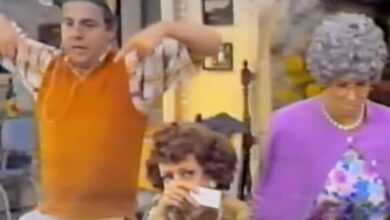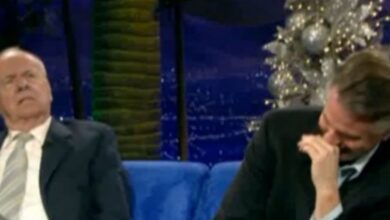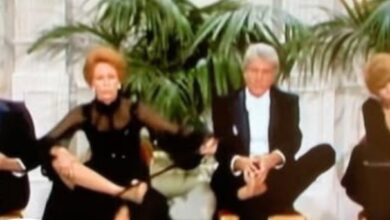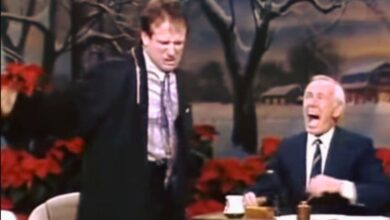Tim Conway’s Slow-Motion Sheriff Destroyed Harvey Korman on Live TV — and Created One of Comedy’s Funniest Meltdowns Ever
Watching Harvey Korman lose his battle to stay composed on live television is one of those comedy experiences that feels timeless, because it taps into something human and irresistible. You can know the sketch is coming, you can even remember the beat-for-beat setup, and still find yourself grinning before Tim Conway even opens his mouth. The joy isn’t just that someone breaks; it’s that the breaking happens in front of you, in real time, like a tiny crack in the universe that lets pure laughter spill into the room.
The Carol Burnett Show had a special kind of chemistry that made these moments possible. It wasn’t only about scripted jokes; it was about a cast that trusted each other enough to take risks and play on the edge of disaster. When you see Korman fighting to hold it together, you’re also seeing that trust at work. He knows Conway is about to throw something unpredictable into the scene, and that nervous anticipation becomes part of the fun for the audience as well.
Tim Conway’s slow-talking sheriff routine works because it’s built on patience, and patience is rare in comedy. Most performers want the laugh quickly, but Conway understood the power of delay. He’d let a sentence stretch, then stretch it again, letting silence become a kind of cruel tease. Each pause feels like a tiny cliffhanger. You’re not laughing because something loud happened; you’re laughing because something is taking so long that your brain starts writing its own jokes in the empty space.
Conway’s physicality is another layer of the magic. The slow movement, the exaggerated squint, the careful steps that look like they’re happening in molasses—these are deliberate choices that turn a normal character into a living cartoon. He doesn’t rush to the next laugh; he milks every inch of the stage as if walking itself is a punchline. That kind of commitment makes the entire sketch feel like a slow-motion trainwreck you can’t look away from.
Harvey Korman was famously one of the best straight men in television comedy, and that’s exactly why his breaking is so electric. He isn’t losing it because he’s sloppy; he’s losing it because Conway is genuinely that funny. Korman’s face becomes a battlefield between professionalism and the unstoppable urge to laugh. Every time he bites his lip or turns away, it’s like watching someone try to stop a sneeze in public and fail.
What’s great is that Korman’s struggle doesn’t ruin the sketch—if anything, it elevates it. In most comedy shows, breaking character would be a mistake. Here, it becomes a second performance running parallel to the first. Conway is delivering the sheriff bit, and Korman is delivering the silent, desperate attempt to stay humanly intact. The audience gets to enjoy both at once, like two comedies stacked on top of each other.
You can often spot the moment when the “outlaw” or the other cast member breaks first, and that’s the spark that lights the fuse. Once another performer cracks, Korman knows he’s in danger. Conway senses it too, and instead of backing off, he doubles down. It becomes a game of comedic chicken: how far can Conway push the absurdity before everyone collapses? The answer, as always, is “further than anyone expects.”
The pacing of the routine is basically a clinic in timing. Conway doesn’t just talk slowly for the gimmick; he uses the slowness to control the room. He knows when to pause so long that the audience starts laughing at the pause itself. He knows when to add a tiny word or a ridiculous detail right at the edge of silence. You can feel him listening to the audience and the cast, adjusting live like a jazz musician.
There’s also something beautiful about the way the studio audience reacts. They aren’t just laughing because it’s “funny TV.” They sense something special happening—something not entirely planned. Their laughter grows louder because they can see the cast teetering. It creates a loop: the audience feeds the performers, the performers feed the audience, and the whole thing snowballs into a kind of joyous chaos that can’t be faked.
Tim Conway’s genius was that he never looked like he was trying to be a genius. His comedy always felt casual, almost innocent, like he’d wandered into the scene and decided to play. That’s why his sheriff character hits so hard. The routine feels like a man sincerely doing his job in the dumbest possible way, not as a comedian winking at you. The sincerity is what lets the absurdity land.
The sheriff sketch also highlights how Conway used language as a tool for mischief. He’d take a simple line and drag it out until it became a new creature altogether. He’d repeat phrases with tiny changes, making them funnier on each pass. It’s the comedic equivalent of turning a screw slowly, watching everyone squirm, and then twisting just a little more when they beg you to stop.
Korman’s laughter, meanwhile, is contagious because it’s not polished. It’s not a performance laugh; it’s an “I can’t believe this is happening” laugh. You can see him wiping tears, trying to reset, then getting ambushed again by Conway’s next slow-motion verbal grenade. The audience at home can’t help but laugh harder because Korman is laughing harder. It becomes a shared collapse.
These moments are a reminder of what live comedy can do that pre-taped comedy can’t. There’s a danger to it—a sense that the entire scene might fall apart. That danger creates stakes, and stakes create excitement. When things go off-script, you feel like you’re witnessing a one-time event. The Carol Burnett Show thrived on that feeling. It made viewers feel like they were in the room, part of the family.
Another reason the sketch still holds up is that it doesn’t rely on references that aged out. It’s about character, timing, and the universal absurdity of someone taking forever to say something simple. Anyone, from any generation, can get pulled into that rhythm. You don’t need context to understand why a slow sheriff with a deadpan stare is funny—it just is, in the way slapstick and timing-based humor always are.
Looking back, you can see how this kind of unscripted breaking became part of the show’s legacy. It wasn’t a flaw; it was an ingredient. It told the audience that what they were watching was alive. It also showed the cast’s respect for Conway’s improvisation. They didn’t shut it down; they survived it together, laughing in the wreckage while the audience cheered them on.
That’s why revisiting this sketch feels so rewarding even now. You’re not just watching a joke. You’re watching a relationship between performers, a live experiment in timing, and a reminder that comedy at its best is a little bit out of control. Conway stretches the scene until the air is oxygen-free, Korman breaks in the most glorious way possible, and for a few minutes, you get to watch television turn into pure, unrepeatable comedy magic.





